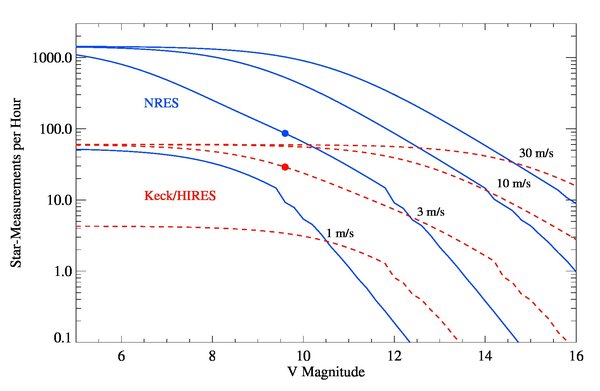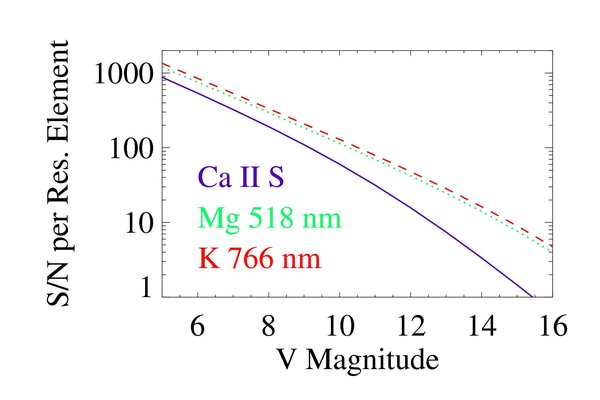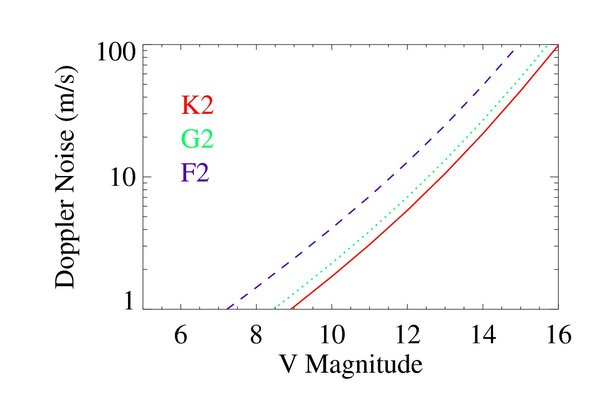NRES Overview
- Fiber-fed, Littrow design with double-pass prism cross-disperser
- Accepts starlight from one or two 1m telescopes
- Resolution (R) ~ 53,000
- Almost full spectral coverage 380 nm - 870 nm in one shot
- Temperature and pressure stabilized for 3 m/s instrinsic stability
- Continuous wavelength calibration with ThAr
- Funded in part by NSF grants from MRI and ATI programs
We plan to deploy 4 NRES spectrographs to 4 sites: (Chile, Texas, South Africa, Israel) in 2017. In Chile and South Africa, each spectrograph will be coupled to 2 X 1m telesocpes. The Texas and Israel sites have only 1 X 1m telescope each. By the end of 2017, we thus expect to have 6 X 1m spectroscopically-capable telescopes, 4 in the southern hemisphere and 2 in the north.
We have parts for 2 more NRES spectrographs, but we have not yet worked out a schedule for deployment or a decision on sites.
Update as of June 1, 2017
Commissioning of NRES-1
The first NRES instrument (NRES-1) is complete, installed in its environmental chamber and attached to two 1m telescopes at CTIO (Chile).
The spectrograph performance parameters are close to the design targets.
Spectral dispersion and the dimensionless resolution R (the ratio of wavelength to the FWHM measured for ThAr emission lines) vary across each echelle order, but not from order to order; this is a consequence of the large incidence angle of light on the grating. The measured linewidths are about 4.15 pixels, almost independent of wavelength. The resolution R is about 44000 at the redmost end of each order, 55000 at the center, and 72000 at the blue end.
To estimate throughput, we measured the number of detected electrons per 4.15-pixel resolution element for two moderate-brightness Sun-like stars: HD76151 (V=6.0, Teff=5500) and HD115383 (V=5.22, Teff=6050). Scaled to V=10.0 and a 10-minute integration time, these measurements give:
These numbers suggest better performance than our TESS target of S/N = 30 for V=11 at an integration time of 1 hour. Throughput will improve when the telescopes' optics are recoated.
We have obtained spectra of stars from 0.4 < V < 11.5 with exposure times 5 sec < Texp < 1 hr.

Environmental chamber servos have been tuned remotely since we left the site. Present temperature stability is better than 5 mK on timescales of 1 day.
Problems encountered:
- When we unpacked the main CCD camera, we found that the coating on the outer surface of the dewar window had begun to peel from the glass. We have never seen this before, and the cause of the damage is undetermined.
- Alignment of the exposure meter optics drifted after the environmental chamber was sealed, causing a loss of sensitivity. We need to open the chamber so we can realign these optics. We are lab-testing a permanent mechanical fix for this tendency to drift. As of May 30, this problem appears to be solved.
- About 10 days after we left the site, a circuit in the CCD controller clock board failed, causing us to be unable to read out the CCD. This problem was traced to a power supply failure. The supply has been replaced, and as of 16 May, the CCD is back on line. We are still working on various readout and minor noise issues.
- Transitioning to full site software operation is proving challenging and time- consuming.
Assembly of NRES-2
NRES-2 is assembled and performs well in the lab. It has been moved into its environmental chamber (igloo). It will be packed for shipment to Texas in mid-June.
Development of Data Reduction Pipeline
The data reduction pipeline corrects raw CCD images for bias, dark current, and stray light, extracts 1-dimensional spectra covering 67 echelle orders and 2 or 3 fibers, identifies about 800
ThAr emission lines from the calibration fiber and uses them to estimate a high-accuracy wavelength solution, and computes a radial velocity estimate. Results are written to a compressed tar file which is stored in a data archive. A searchable database of metadata will allow quick location and retrieval of data for any selected objects or observing times.
Work is proceeding on a queue system that will run the pipeline on an LCO server, so that the NRES pipeline will be invoked automatically for each incoming data file, performing near-real-time reduction of NRES data. We plan to make the pipeline available in three successive versions.
(v1 - due Aug 1) Performs automatic calibrations, extracts to 1-dimensional (per order) spectra, estimates wavelength solution from ThAr spectrum. Performs a rudimentary radial-velocity analysis, meant (at first) largely as a testbed for later improvements. Produces diagnostic plots and a tarball of intermediate and final data products.
(v2) Provide user access to and analysis of data from the exposure meter and from the autoguiders; also from the radial velocity analysis.
(v3) Perform an automated classification of the target star in terms of the parameters {Teff, log(g), log(Z), vsini}, and add information about this analysis and its result to the output tarball.
Schedule for remaining installations
Given the scientific motivation for NRES, the prime figure-of-merit is how many distinct RV observations per hour of wall-clock time the facility can obtain at given precision and target star magnitude. The figure below compares this figure-of-merit for NRES (solid blue) with Keck/HIRES (dashed red). The figure refers to random errors (precision), not systematic ones (accuracy). The different lines represent a variety of Doppler precisions (1, 3, 10, and 30 m/s), labeled at the intersection between the red and blue lines, i.e. where NRES and Keck/HIRES are equally productive. To the left of these intersections (brighter stars), NRES is more efficient than Keck/HIRES for the specified RV precision.

The startling conclusion from this figure is that even for RV precision as good as a few m/s, NRES outperforms Keck/HIRES for stars as faint as V = 12. And with a (30 m/s) precision sufficient to detect Hot Jupiters, NRES can produce RV samples faster than Keck/HIRES to V = 15! Given that Keck has 8.33 times more collecting area than all twelve 1-meter telescopes combined, this behavior is surprising. The superior performance of NRES arises from three sources: 1. the number of telescopes, 2. optical efficiency, and 3. operational efficiency. To illustrate the latter two, consider stars with V = 9.5, with a desired precision of 3 m/s, indicated with dots on the above figure. In this parameter range, both Keck and NRES are limited by photon noise; detector read noise is negligible and noise from p-modes is unimportant. The figure-of-merit thus transforms simply to the number of detected photons per hour of wall-clock time. The optical efficiency of NRES will be higher than Keck/HIRES primarily because NRES will calibrate spectra using a fiber connected to a ThAr lamp, as opposed to the I2 absorption cell used on HIRES. This increases the usable wavelength range by a factor of about 3, avoids I2 pseudo-continuum absorption, and gives useful data at blue wavelengths where the density of absorption lines is large. As confirmed by the HARPS spectrograph, the combined efficiency gain is about a factor of 6 (
Pepe et al., 2003). Also, the NRES optics have fewer surfaces, use prism (not grating) cross-dispersion, and have smaller “slit” losses, making them more transmissive than HIRES by a factor of about 2. Finally, at 3 m/s, the needed integration times are 8 min for NRES, but 1 min for Keck/HIRES. To observe many targets with a typical 1-min slew-settle time, the larger telescope loses a factor of 2 in duty cycle, whereas NRES loses only 6%. Combining these factors gives NRES the advantage by nearly a factor of 3. Note that a comparison between NRES and HARPS (which uses fiber/ThAr calibration) would be almost identical. Although the total aperture of NRES is about equal to that of HARPS, NRES also gains from smaller overheads and a simplified, prism-based design.


Above: Simulated performance of the NRES spectrograph as a function of stellar magnitude, for an integration time of 20 minutes. (a) S/N for three useful wavelength regimes, including for the Mt. Wilson S-index. (b) RV precision determined from photon plus read noise, for a variety of stellar types, assuming vsini = 2 km/s.
The figure on the left shows that in 20 min, NRES will provide classifications at S/N = 10 even below V = 14, corresponding to fairly faint Kepler targets. For V ≤ 12, which will cover all of the stars surveyed by TESS, S/N = 30 classification is feasible. To classify the expected 20,000 TESS stars that will show transit-like signals requires about 6700 hours of 1-meter telescope time. Over a 3-year period, this is about 7% of the total observing time available to the network. For planet candidate vetting at vsini = 2 km/s for the same stars, RV measurements with accuracy of 30 m/s will need less than 8 min of observing time per star, or about 3% of the total network time. Vetting at V=14 will be possible, but slower. Higher accuracy of 3 m/s will be attainable in an hour for V = 12. For a plausibly-scaled program to measure orbital parameters, devoting 9% of the 1-m network observing time, NRES will provide 3 m/s Doppler accuracy for 500 stars, with 20 observing epochs per star over 3 years. (Of course, faster-rotating or lower-metallicity stars will take longer.) Performance at this level will be adequate for a large majority of the expected transiting planet follow-up; only the faintest and most difficult targets, or those needing precision better than 3 m/s, will require observations from larger telescopes.
For favorable cases, the RM signal can exceed 50 m/s, while the smallest signal yet detected is about 1.5 m/s, corresponding to a Neptune-size body transiting the slow-rotating star HAT-P-11 (
Winn et al., 2010). To properly sample a RM radial velocity curve requires time resolution comparable to transit ingress/egress times – typically 5 minutes. Results from multiple transits or multiple telescopes may however be averaged together. We therefore target 3 m/s precision in 4 x 5-min observations on a typical star with V = 10. For large planets circling stars brighter than V ∼ 12 and vsini > 2 km/s, NRES will give RM data with usefully low noise within a single transit. For fainter stars or smaller planets, one may combine data from multiple telescopes and transits. For instance, the HAT-P-11b results by Winn et al. (
2010) based on 2 transits observed with Keck/HIRES could be reproduced by using pairs of telescopes (attached to the same spectrograph), and combining results from 4 transits. Because of LCO’s multiple sites, large number of telescopes, and flexible scheduling, such coordinated observing strategies will be routine.
Ca II studies of stellar magnetic activity are promising. Observations of the S index (
Vaughan et al., 1978) that are precise to 1% or so should be possible in 20 minutes down to V = 7, and with 10% precision to V = 12. With NRES, one could for follow the entire target list of the Lowell stellar activity survey (147 stars, most brighter than V = 7.5;
Hall et al., 2007) with weekly activity measurements, using about 6% of the network capacity.



